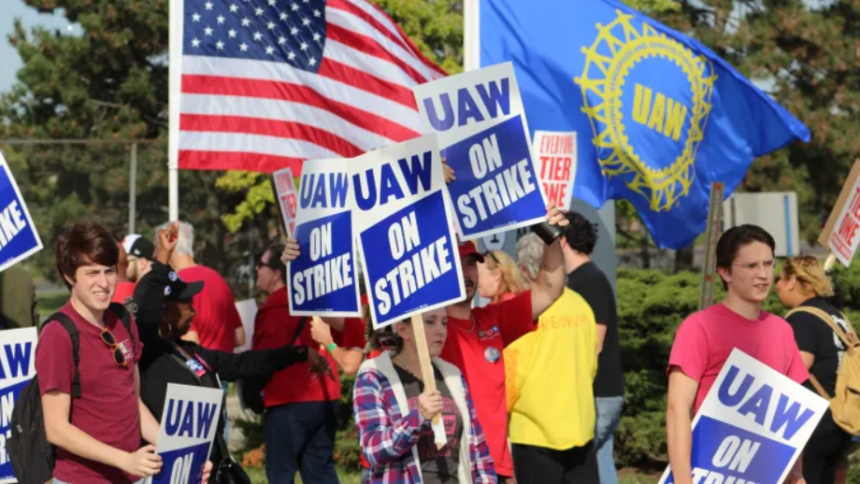On September 25, 2019, United Auto Workers protesters gathered on wall street outside the Detroit-Hamtramck Assembly plant of General Motors.
- ESSENTIAL POINTS
- Many people on Wall Street believe that possible UAW strikes against Detroit automakers would be generally controllable and perhaps present investment opportunities.
- Others feel the Detroit automakers can handle such work stoppages and anticipated increases in labor costs, while some think prospective strikes have already been included into the stocks.
- Before any strikes, the Detroit automakers and UAW have until Thursday at 11:59 p.m. ET to independently agree new contracts for the roughly 146,000 union members.

DETROIT – A lot of people on Wall Street think that possible United Auto Workers strikes against Detroit automakers would be relatively controllable and potentially present investment opportunities.
Others believe General Motors, Ford Motor, and Stellantis, together known as the Detroit automakers, or D-3, can manage such work stoppages and anticipated increases in labor costs. Some people think probable strikes have already been included into the stocks. 146,000 union members’ contracts are being negotiated between the firms and the union before a deadline of Thursday at 11:59 p.m. ET.

“Our theoretical math suggests that labor cost increases should largely be manageable for the D-3. Further, a work stoppage should keep inventories low and support prices staying elevated, which should be a near term offset for higher wages,”Tom Narayan, an analyst at RBC Capital Markets, stated in a letter to investors on Thursday.
The margin impacts of union employee rises of 10% and 20% were calculated by RBC to be 0.39% and 0.79%, respectively, using Ford as an example, which has the most UAW employees with 57,000. prospective incentives and other prospective adjustments, such as cost-of-living adjustments, which the union has prioritized, are not taken into account.

What “matters most” is the length of a prospective strike, according to Philippe Houchois, an analyst at Jefferies. He predicts each week of a strike may cost Ford, GM, and Stellantis between 4% and 5% of adjusted profits, 3% to 4%, and 1.5% to 2%, respectively, of adjusted earnings.
The UAW has hinted about conducting simultaneous nationwide wall street strikes against the Detroit automakers, although this has never been done before. The automobile supply chain, the American economy, and domestic manufacturing may all be impacted. Additionally, the corporations would probably suffer billion-dollar losses in terms of production, sales, and other revenues.

The carmaker said at the time that a wall street strike against GM in 2019 during the most recent round of contract talks lasted 40 days and lost the business $3.6 billion in earnings.
According to Adam Jonas, a Morgan Stanley analyst, the company is primarily a buyer “across much of our sector leading up to and during contract negotiations.” He calculates that just 4% of the global revenues for the Detroit automakers are attributable to labor expenses.
“Bottom line, we’d be a buyer of both F and GM right now and during the negotiations as we believe even a ‘difficult’ outcome can catalyze far bigger changes to strategy and capital discipline that will eventually yield significant and longer lasting benefits to shareholders that will exceed today’s labor headlines,”On August 28, Jonas made a statement.
A wall street strike, according to Jonas, may be beneficial for used vehicle pricing as well as for dealers and rental car firms like Avis Budget Group and Hertz.
BofA Securities about wall street strike
A UAW wall street strike might “drive some headline-related downwards movement to the stocks, but the stocks largely reflect the risks of a material strike,” said BofA Securities analyst John Murphy on Friday.
If initial agreements are made, the union’s demands might potentially be expensive. Among other things on the table, key demands have included a 40% boost in hourly pay, a cutback to a 32-hour work week, a return to conventional pensions, the abolition of compensation levels, and the reintroduction of cost-of-living adjustments.
ALSO READ: A Lazard Banker Expresses “Huge Concern” Over SpaceX’s Near-Monopoly On Rocket Launches
image source: google




































